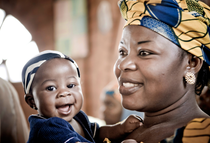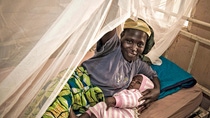Agriculture
35 Million Nets to Boost the Fight Against Malaria
Eliminating malaria remains one of humanity’s most serious challenges. The World Health Organization estimates there were 241 million cases of malaria and 627,000 deaths caused by the disease in 2020, the majority in sub-Saharan Africa. Children under the age of five and pregnant women are particularly at risk. However, malaria is curable and, most importantly, preventable.
Insecticide-treated nets (ITNs) are highly effective in preventing malaria and killing mosquitoes. But growing resistance to insecticides in mosquitoes threatens recent achievements. This is why the launch of BASF’s innovative Interceptor® G2 ITNs has been eagerly anticipated. Despite the challenges posed by the Covid-19 pandemic and severely disrupted supply chains, 35 million nets have now been delivered under the New Nets Project.
Beginning in 2000, public health bodies, funding institutions, NGOs and other stakeholders strengthened their efforts to eliminate malaria. As a result, a great deal of progress was made at reducing cases of malaria. But despite this concerted commitment and much scientific effort, from 2017, progress began to plateau and cases rose again.
One reason for this is that mosquitoes have become increasingly resistant to the insecticides used to eliminate malaria. As a result, it has been clear for some time that new tools are needed to reboot the fight against the disease. The New Nets Project, funded by The Global Fund and UNITAID, and led by the Innovative Vector Control Consortium (IVCC), has worked with industry partners to provide funding to facilitate the implementation of ITNs treated with new insecticide combinations.
The development of the novel second-generation Interceptor® G2 ITN by New Nets Project’s industry partner BASF offers a powerful solution to overcome the problem of insecticide resistance. In contrast to standard mosquito nets based solely on pyrethroid chemistry, the new nets contain an innovative combination of chlorfenapyr and alpha-cypermethrin.
This represents a groundbreaking innovation – one that has been many years in development.

A complex process
From the initial concept to the final production stages, it is a long path before a new product can be safely deployed for use in malaria prevention. The technical development is followed by rigorous testing and requires approval from a number of institutions and stakeholders.
The first samples were created in the labs at BASF in 2008 and subsequently tested in Africa to verify the concept of the dual chlorfenapyr/alphacypermethrin treated netting. In 2014 the innovative nets were submitted to WHO for independent assessment. In 2017, after eleven years of research and development, WHO announced their recommendation endorsing Interceptor® G2 but at the same time asking for two epidemiology trials.
A two-year epidemiological trial was initiated in 2019 to prove the public health value of the Interceptor® G2 nets. According to the test results, which were published in The Lancet in March 2022, a 44 percent reduction of malaria incidents was achieved in comparison to pyrethroid only treated nets. A second epidemiological trial in Benin is in its final stages and the results will be published shortly.
After the rollout of the 35 million IG2 nets, Jessica Rockwood, President International Public Health Advisors, spoke to stakeholders involved with the implementation in Ghana and Nigeria and the Alliance for Malaria Prevention (AMP). Their insights into user acceptance, the feedback they have received on the use of the new Interceptor® G2 nets as well as their experiences during the COVID-19 pandemic and the supply chain disruptions provide valuable input for the rollout in other countries and the future development and distribution of the next generation of nets.
Interceptor® G2 milestones
We have reached remarkable achievements in the fight against malaria, especially insecticide resistance. Thanks to our trustful collaborations with partners that has led to this game-changing innovation. Learn more about our wins against this deadly disease from the lab to the people we support.
Please click on the hot spot (>) of your choice in the timeline.
Challenges posed by COVID-19
The pandemic impacted malaria programs in various ways and at different stages.
In 2020, when it first hit, many countries already had ITNs in place and it was a question of how to distribute them safely and effectively.
“Availability of personal protective equipment was also a challenge, given the hugely increased demand and long timelines for delivery to countries through international procurement and increased pricing at national level.”
In 2021, supply chain disruptions added to the problem, delaying the delivery of ITNs. Meanwhile, COVID-19 had created other unexpected problems. “In some countries, rumors have been a challenge, particularly when ITNs were distributed at periods when COVID-19 cases were on the increase, creating a perception that the ITNs ‘brought’ the COVID,” says Erskine.
This showed the importance of transparent communication and the necessity for having rumor management plans in place. In Nigeria acceptance has been high thanks to well-targeted communications. “Our strategy was just to communicate that these are better nets that will work better with the mosquitoes in your state. We kept it very simple,” says Fatima Ali, Principal Scientific Officer at Nigeria’s National Malaria Elimination Programme.
Dr. Keziah Malm, Director National Malaria Control Programme in Ghana, highlights another challenge during the pandemic. “We had to deal with severe human resource issues. Many people were either sick or had to take care of those infected or were deployed in preventive contact tracing,” she says. “We also had to adapt our communication channels. Instead of public debates we used the radio and carried on communicating one to one.”
Firsthand experiences
While providing information on the appropriate use of nets and proper handling of plastic waste play a vital role in the post-distribution stages, it is also vital to listen closely to what those using the nets say. The teams in the various regions received firsthand feedback on the design and use of the nets in practice, regarding everything from the texture to the color and shape of the nets.
The main issue, though, is social and behavior change. “Some designs may be more acceptable than others, but I think the real issues go beyond the style or the shape of the nets,” says Ms Ali. “It is more about people adopting net use – a net culture, if you like – and using them every night. So, I think it is good to look at it as a social and behavior change problem first. I think you solve that before you go into the technicalities of what shape and what the design of the net is.”
In this respect, Ms Ali believes that more work could be done, particularly post distribution, if the funding was available. “I think we need to continue encouraging people to use their nets for six months or a year after distribution and we need to explain over and again how to utilize them,” she says. “That’s the best way to maximize the benefits of the nets and really make a difference.”
Dedicated partnerships are key
While trials, data collection and evaluation are still under way in many regions, the data that has emerged through the New Nets Project so far and the recent Randomized Controlled Trial in Tanzania suggest that enthusiasm for the Interceptor® G2 is justified. The final evaluation and a recommendation by WHO will, hopefully, further meet expectations. But the successful launch would not have been possible without the project’s dedicated partners.
To date, Interceptor® G2 has been registered in 20 countries, predominantly in sub-Saharan Africa, and the target of supplying 35 million nets for distribution has been met. The achievement is remarkable considering the problems that have been caused by the global COVID-19 pandemic and the subsequent supply chain disruptions that threatened the smooth roll out. These challenges were overcome thanks to the dedication and perseverance of many people, from R&D through to implementation. With further disruptions anticipated, it will continue to be vital to work with all stakeholders in close partnership.
Outlook – Interceptor® G3
The experience of the development, distribution and feedback from partners and people from the communities will shape the development of the next generation Interceptor® G3, which is already under way. To push the project further, BASF envisage getting partners and customers involved in the process early on to build on the experiences from the rollout and the feedback concerning product design, social and behavior change communication and distribution - as well as post-distribution activities.
Ms. Rockwood believes that a combination of measures will have a positive effect. “Dual active ingredient ITNs, a focus on sustained social and behavior change to encourage net care, and investment in better access to and use of ITNs are all important success factors in the fight against malaria,” she says.
Dr. Malm is confident that the new nets will make a difference.
I am very happy that the study published in The Lancet has shown that there can be a significant impact on reducing malaria prevalence with the new dual active ingredients nets compared to the standard insecticide-treated nets.
There is hope among those working to end malaria that more progress will be made, in spite of all the challenges.




